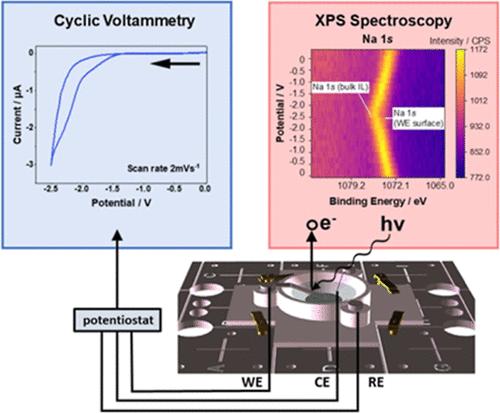当前位置:
X-MOL 学术
›
ACS Appl. Mater. Interfaces
›
论文详情
Our official English website, www.x-mol.net, welcomes your feedback! (Note: you will need to create a separate account there.)
Monitoring the Behavior of Na Ions and Solid Electrolyte Interphase Formation at an Aluminum/Ionic Liquid Electrode/Electrolyte Interface via Operando Electrochemical X-ray Photoelectron Spectroscopy
ACS Applied Materials & Interfaces ( IF 8.3 ) Pub Date : 2024-06-27 , DOI: 10.1021/acsami.4c02241 Roxy Lee 1 , Tim S. Nunney 2 , Mark Isaacs 1, 3 , Robert G. Palgrave 1 , Avishek Dey 1, 4
ACS Applied Materials & Interfaces ( IF 8.3 ) Pub Date : 2024-06-27 , DOI: 10.1021/acsami.4c02241 Roxy Lee 1 , Tim S. Nunney 2 , Mark Isaacs 1, 3 , Robert G. Palgrave 1 , Avishek Dey 1, 4
Affiliation

|
In electrochemical energy storage devices, the interface between the electrode and the electrolyte plays a crucial role. A solid electrolyte interphase (SEI) is formed on the electrode surface due to spontaneous decomposition of the electrolyte, which in turn controls the dynamics of ion migration during charge and discharge cycles. However, the dynamic nature of the SEI means that its chemical structure evolves over time and as a function of the applied bias; thus, a true operando study is extremely valuable. X-ray photoelectron spectroscopy (XPS) is a widely used technique to understand the surface electronic and chemical properties, but the use of ultrahigh vacuum in standard instruments is a major hurdle for their utilization in measuring wet electrochemical processes. Herein, we introduce a 3-electrode electrochemical cell to probe the behavior of Na ions and the formation of SEI at the interface of an ionic liquid (IL) electrolyte and an aluminum electrode under operando conditions. A system containing 0.5 molar NaTFSI dissolved in the IL [BMIM][TFSI] was investigated using an Al working electrode and Pt counter and reference electrodes. By optimizing the scan rate of both XPS and cyclic voltammetry (CV) techniques, we captured the formation and evolution of SEI chemistry using real-time spectra acquisition techniques. A CV scan rate of 2 mVs–1 was coupled with XPS snapshot spectra collected at 10 s per core level. The technique demonstrated here provides a platform for the chemical analysis of materials beyond batteries.
中文翻译:

通过 Operando 电化学 X 射线光电子能谱监测铝/离子液体电极/电解质界面上钠离子和固体电解质界面形成的行为
在电化学储能装置中,电极和电解质之间的界面起着至关重要的作用。由于电解质的自发分解,在电极表面形成固体电解质中间相(SEI),这反过来又控制充电和放电循环期间离子迁移的动力学。然而,SEI 的动态性质意味着其化学结构会随着时间的推移而变化,并作为所施加偏压的函数而变化;因此,真正的操作研究是极其有价值的。 X 射线光电子能谱 (XPS) 是一种广泛用于了解表面电子和化学性质的技术,但标准仪器中超高真空的使用是其用于测量湿电化学过程的主要障碍。在此,我们引入了一种 3 电极电化学电池来探测 Na 离子的行为以及在操作条件下离子液体 (IL) 电解质和铝电极界面处 SEI 的形成。使用 Al 工作电极以及 Pt 对电极和参比电极研究了溶解在 IL [BMIM][TFSI] 中的 0.5 摩尔 NaTFSI 的系统。通过优化 XPS 和循环伏安 (CV) 技术的扫描速率,我们使用实时光谱采集技术捕获了 SEI 化学的形成和演变。 2 mVs –1 的 CV 扫描速率与每个核心水平 10 秒收集的 XPS 快照光谱相结合。这里演示的技术为电池以外的材料的化学分析提供了一个平台。
更新日期:2024-06-27
中文翻译:

通过 Operando 电化学 X 射线光电子能谱监测铝/离子液体电极/电解质界面上钠离子和固体电解质界面形成的行为
在电化学储能装置中,电极和电解质之间的界面起着至关重要的作用。由于电解质的自发分解,在电极表面形成固体电解质中间相(SEI),这反过来又控制充电和放电循环期间离子迁移的动力学。然而,SEI 的动态性质意味着其化学结构会随着时间的推移而变化,并作为所施加偏压的函数而变化;因此,真正的操作研究是极其有价值的。 X 射线光电子能谱 (XPS) 是一种广泛用于了解表面电子和化学性质的技术,但标准仪器中超高真空的使用是其用于测量湿电化学过程的主要障碍。在此,我们引入了一种 3 电极电化学电池来探测 Na 离子的行为以及在操作条件下离子液体 (IL) 电解质和铝电极界面处 SEI 的形成。使用 Al 工作电极以及 Pt 对电极和参比电极研究了溶解在 IL [BMIM][TFSI] 中的 0.5 摩尔 NaTFSI 的系统。通过优化 XPS 和循环伏安 (CV) 技术的扫描速率,我们使用实时光谱采集技术捕获了 SEI 化学的形成和演变。 2 mVs –1 的 CV 扫描速率与每个核心水平 10 秒收集的 XPS 快照光谱相结合。这里演示的技术为电池以外的材料的化学分析提供了一个平台。






































 京公网安备 11010802027423号
京公网安备 11010802027423号